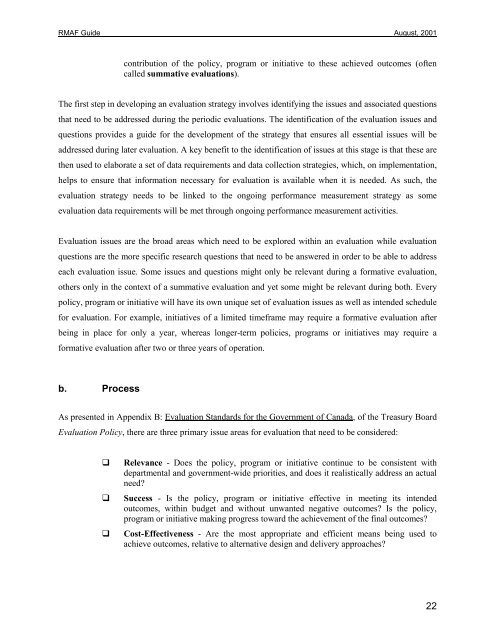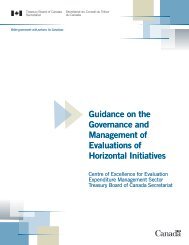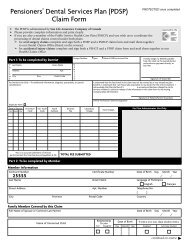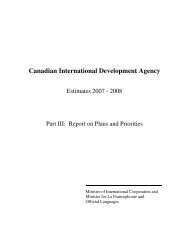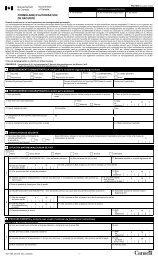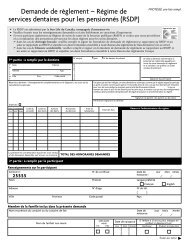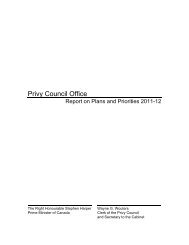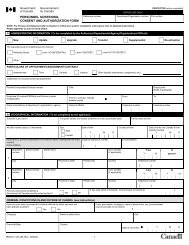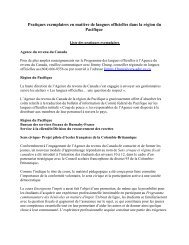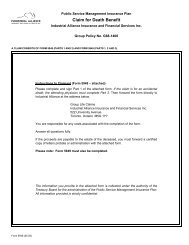RMAF <strong>Guide</strong> August, 2001contribution <strong>of</strong> <strong>the</strong> policy, program or initiative to <strong>the</strong>se achieved outcomes (<strong>of</strong>tencalled summative evaluations).The first step in developing an evaluation strategy involves identifying <strong>the</strong> issues <strong>and</strong> associated questionsthat need to be addressed during <strong>the</strong> periodic evaluations. The identification <strong>of</strong> <strong>the</strong> evaluation issues <strong>and</strong>questions provides a guide <strong>for</strong> <strong>the</strong> development <strong>of</strong> <strong>the</strong> strategy that ensures all essential issues will beaddressed during later evaluation. A key benefit to <strong>the</strong> identification <strong>of</strong> issues at this stage is that <strong>the</strong>se are<strong>the</strong>n used to elaborate a set <strong>of</strong> data requirements <strong>and</strong> data collection strategies, which, on implementation,helps to ensure that in<strong>for</strong>mation necessary <strong>for</strong> evaluation is available when it is needed. As such, <strong>the</strong>evaluation strategy needs to be linked to <strong>the</strong> ongoing per<strong>for</strong>mance measurement strategy as someevaluation data requirements will be met through ongoing per<strong>for</strong>mance measurement activities.Evaluation issues are <strong>the</strong> broad areas which need to be explored within an evaluation while evaluationquestions are <strong>the</strong> more specific research questions that need to be answered in order to be able to addresseach evaluation issue. Some issues <strong>and</strong> questions might only be relevant during a <strong>for</strong>mative evaluation,o<strong>the</strong>rs only in <strong>the</strong> context <strong>of</strong> a summative evaluation <strong>and</strong> yet some might be relevant during both. Everypolicy, program or initiative will have its own unique set <strong>of</strong> evaluation issues as well as intended schedule<strong>for</strong> evaluation. For example, initiatives <strong>of</strong> a limited timeframe may require a <strong>for</strong>mative evaluation afterbeing in place <strong>for</strong> only a year, whereas longer-term policies, programs or initiatives may require a<strong>for</strong>mative evaluation after two or three years <strong>of</strong> operation.b. ProcessAs presented in Appendix B: Evaluation St<strong>and</strong>ards <strong>for</strong> <strong>the</strong> Government <strong>of</strong> Canada, <strong>of</strong> <strong>the</strong> Treasury BoardEvaluation Policy, <strong>the</strong>re are three primary issue areas <strong>for</strong> evaluation that need to be considered:Relevance - Does <strong>the</strong> policy, program or initiative continue to be consistent withdepartmental <strong>and</strong> government-wide priorities, <strong>and</strong> does it realistically address an actualneed?Success - Is <strong>the</strong> policy, program or initiative effective in meeting its intendedoutcomes, within budget <strong>and</strong> without unwanted negative outcomes? Is <strong>the</strong> policy,program or initiative making progress toward <strong>the</strong> achievement <strong>of</strong> <strong>the</strong> final outcomes?Cost-Effectiveness - Are <strong>the</strong> most appropriate <strong>and</strong> efficient means being used toachieve outcomes, relative to alternative design <strong>and</strong> delivery approaches?22
RMAF <strong>Guide</strong> August, 2001For every policy, program or initiative, consideration must be given to <strong>the</strong>se key evaluation issues (i.e.,relevance, success <strong>and</strong> cost-effectiveness). Relevance issues might include whe<strong>the</strong>r <strong>the</strong> policy, program orinitiative is <strong>the</strong> most appropriate response to an identified need. There may also be issues around whe<strong>the</strong>r<strong>the</strong> identified need which led to <strong>the</strong> implementation <strong>of</strong> <strong>the</strong> policy, program or initiative has changed.Issues related to success involve measuring <strong>the</strong> results achieved throughout <strong>the</strong> sequence <strong>of</strong> outcomes aspresented in <strong>the</strong> logic model, or <strong>the</strong> degree <strong>of</strong> progress toward <strong>the</strong> attainment <strong>of</strong> <strong>the</strong> final outcome. Inaddition, questions should also be raised to explore <strong>the</strong> degree to which unintended positive or negativeoutcomes have resulted from <strong>the</strong> policy, program or initiative. Cost-effectiveness is tied to relatingresources expended to per<strong>for</strong>mance in terms <strong>of</strong> outputs <strong>and</strong> outcomes.As well, issues related to <strong>the</strong> implementation or delivery <strong>of</strong> a policy, program or initiative should beconsidered within <strong>the</strong> set <strong>of</strong> evaluation issues. Here, questions address how <strong>the</strong> policy, program orinitiative is actually being implemented compared to how it was intended to be implemented. Aspects <strong>of</strong>delivery also come into question here, including assessment <strong>of</strong> <strong>the</strong> outputs <strong>and</strong> <strong>the</strong> reach (i.e., <strong>the</strong> degreeto which <strong>the</strong> intended beneficiaries are being reached).The adequacy <strong>of</strong> <strong>the</strong> per<strong>for</strong>mance measurement strategy should also be <strong>the</strong> focus <strong>of</strong> an evaluationquestion.There are several methods that can be used to identify <strong>the</strong> set <strong>of</strong> appropriate evaluation issues <strong>and</strong>associated questions. Certainly, a careful review <strong>of</strong> documents associated with <strong>the</strong> policy, program orinitiative is an excellent place to start as this may uncover aspects that should receive attention in anevaluation. In addition, interviews with managers, designers, staff <strong>and</strong> key stakeholders will clarify what<strong>the</strong> key evaluation interests are <strong>for</strong> those people most closely associated with <strong>the</strong> policy, program orinitiative.Once a comprehensive list <strong>of</strong> evaluation issues <strong>and</strong> associated questions has been established, a process <strong>of</strong>prioritisation <strong>the</strong>n needs to occur to ensure that <strong>the</strong> final set <strong>of</strong> issues is reasonable <strong>and</strong> realistic.As no evaluation endeavour could successfully address all possible issues <strong>and</strong>questions, it is important to review <strong>the</strong> list to separate those questions which necessarilyneed to be addressed from those which are not critical <strong>for</strong> evaluation, but are insteadquestions <strong>for</strong> which <strong>the</strong> answers would be “nice to know.”23
- Page 1 and 2: Guide for the Development ofResults
- Page 3 and 4: RMAF Guide August, 2001Section 1.In
- Page 5 and 6: RMAF Guide August, 2001All three of
- Page 7 and 8: RMAF Guide August, 2001EXHIBIT 1.1T
- Page 9 and 10: RMAF Guide August, 20011.5 What are
- Page 11 and 12: RMAF Guide August, 2001Section 3.St
- Page 13 and 14: RMAF Guide August, 20013.2 Logic Mo
- Page 15 and 16: RMAF Guide August, 2001(Exhibit 3.1
- Page 17 and 18: RMAF Guide August, 2001specific lin
- Page 19 and 20: RMAF Guide August, 2001Ongoing perf
- Page 21 and 22: RMAF Guide August, 20013.3.2 Measur
- Page 23: RMAF Guide August, 2001The ongoing
- Page 27 and 28: RMAF Guide August, 2001identificati
- Page 29 and 30: RMAF Guide August, 2001b. ProcessTh
- Page 31 and 32: RMAF Guide August, 2001As well, mos
- Page 33 and 34: RMAF Guide August, 2001Review data
- Page 35 and 36: RMAF Guide August, 2001LEXICONResul
- Page 37 and 38: RMAF Guide August, 2001 Performance
- Page 39 and 40: RMAF Guide August, 2001Annex BCrite
- Page 41 and 42: RMAF Guide August, 20013. Performan
- Page 43 and 44: RMAF Guide August, 2001Annex CSampl
- Page 45 and 46: RMAF Guide August, 2001Annex D:Samp


